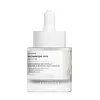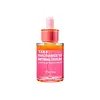What's inside
What's inside
 Key Ingredients
Key Ingredients

 Benefits
Benefits

 Concerns
Concerns

No concerns
 Ingredients Side-by-side
Ingredients Side-by-side

Water
Skin ConditioningButylene Glycol
HumectantNiacinamide
Smoothing1,2-Hexanediol
Skin ConditioningAscorbyl Glucoside
AntioxidantPropanediol
SolventCarbomer
Emulsion StabilisingMethylpropanediol
SolventTromethamine
BufferingXanthan Gum
EmulsifyingTranexamic Acid
AstringentCentella Asiatica Extract
CleansingPolyglutamic Acid
Skin ConditioningHydrolyzed Sponge
Skin ConditioningDisodium EDTA
Citric Acid
BufferingSodium Dna
Skin ConditioningEthylhexylglycerin
Skin ConditioningTocopheryl Acetate
AntioxidantPanthenol
Skin ConditioningMadecassoside
AntioxidantWater, Butylene Glycol, Niacinamide, 1,2-Hexanediol, Ascorbyl Glucoside, Propanediol, Carbomer, Methylpropanediol, Tromethamine, Xanthan Gum, Tranexamic Acid, Centella Asiatica Extract, Polyglutamic Acid, Hydrolyzed Sponge, Disodium EDTA, Citric Acid, Sodium Dna, Ethylhexylglycerin, Tocopheryl Acetate, Panthenol, Madecassoside
Water
Skin ConditioningNiacinamide
SmoothingTranexamic Acid
AstringentGlycerin
HumectantCaprylic/Capric Triglyceride
Masking1,2-Hexanediol
Skin ConditioningMethylpropanediol
SolventPentylene Glycol
Skin ConditioningPvp
Emulsion StabilisingAmmonium Acryloyldimethyltaurate/Vp Copolymer
Butylene Glycol
HumectantAgar
MaskingGellan Gum
Ethylhexylglycerin
Skin ConditioningSodium Citrate
BufferingHydroxyacetophenone
AntioxidantCitric Acid
BufferingHydroxydecyl Ubiquinone
AntioxidantAdenosine
Skin ConditioningLactococcus Ferment Lysate
Skin ConditioningHydrogenated Lecithin
EmulsifyingCentella Asiatica Extract
CleansingFicus Carica Fruit Extract
HumectantFructooligosaccharides
HumectantCyanocobalamin
Skin ConditioningXanthan Gum
EmulsifyingRetinal
Skin ConditioningCeramide NP
Skin ConditioningArginine
MaskingTocopherol
AntioxidantGlutathione
Bisabolol
MaskingHelianthus Annuus Seed Oil
EmollientAllantoin
Skin ConditioningXanthophylls
Skin ConditioningSodium Chloride
MaskingPhenylpropanol
MaskingLevulinic Acid
PerfumingSodium Levulinate
Skin ConditioningWater, Niacinamide, Tranexamic Acid, Glycerin, Caprylic/Capric Triglyceride, 1,2-Hexanediol, Methylpropanediol, Pentylene Glycol, Pvp, Ammonium Acryloyldimethyltaurate/Vp Copolymer, Butylene Glycol, Agar, Gellan Gum, Ethylhexylglycerin, Sodium Citrate, Hydroxyacetophenone, Citric Acid, Hydroxydecyl Ubiquinone, Adenosine, Lactococcus Ferment Lysate, Hydrogenated Lecithin, Centella Asiatica Extract, Ficus Carica Fruit Extract, Fructooligosaccharides, Cyanocobalamin, Xanthan Gum, Retinal, Ceramide NP, Arginine, Tocopherol, Glutathione, Bisabolol, Helianthus Annuus Seed Oil, Allantoin, Xanthophylls, Sodium Chloride, Phenylpropanol, Levulinic Acid, Sodium Levulinate
 Reviews
Reviews

Ingredients Explained
These ingredients are found in both products.
Ingredients higher up in an ingredient list are typically present in a larger amount.
1,2-Hexanediol is a synthetic liquid and another multi-functional powerhouse.
It is a:
- Humectant, drawing moisture into the skin
- Emollient, helping to soften skin
- Solvent, dispersing and stabilizing formulas
- Preservative booster, enhancing the antimicrobial activity of other preservatives
Butylene Glycol (or BG) is used within cosmetic products for a few different reasons:
Overall, Butylene Glycol is a safe and well-rounded ingredient that works well with other ingredients.
Though this ingredient works well with most skin types, some people with sensitive skin may experience a reaction such as allergic rashes, closed comedones, or itchiness.
Learn more about Butylene GlycolCentella Asiatica Extract (Centella) is derived from an herb native to Southeast Asia. It is famous for its anti-inflammatory and soothing properties.
Centella is rich in antioxidants and amino acids, such as Madecassic Acid and Asiaticoside.
Studies show the compounds in centella help with:
The combination of all these properties makes centella effective at soothing, hydrating, and protecting the skin.
Other great components of centella include Vitamin A, vitamin C, several B vitamins, and Asiatic Acid.
Fun fact: Centella has been used as a medicine and in food for many centuries. As a medicine, it is used to treat burns, scratches, and wounds.
Learn more about Centella Asiatica ExtractCitric Acid is an alpha hydroxy acid (AHA) naturally found in citrus fruits like oranges, lemons, and limes.
Like other AHAs, citric acid can exfoliate skin by breaking down the bonds that hold dead skin cells together. This helps reveal smoother and brighter skin underneath.
However, this exfoliating effect only happens at high concentrations (20%) which can be hard to find in cosmetic products.
Due to this, citric acid is usually included in small amounts as a pH adjuster. This helps keep products slightly more acidic and compatible with skin's natural pH.
In skincare formulas, citric acid can:
While it can provide some skin benefits, research shows lactic acid and glycolic acid are generally more effective and less irritating exfoliants.
Most citric acid used in skincare today is made by fermenting sugars (usually from molasses). This synthetic version is identical to the natural citrus form but easier to stabilize and use in formulations.
Read more about some other popular AHA's here:
Learn more about Citric AcidEthylhexylglycerin (we can't pronounce this either) is commonly used as a preservative and skin softener. It is derived from glyceryl.
You might see Ethylhexylglycerin often paired with other preservatives such as phenoxyethanol. Ethylhexylglycerin has been found to increase the effectiveness of these other preservatives.
Methylpropanediol is a synthetic solvent and humectant.
As a solvent, it helps dissolve other ingredients, helping to evenly distribute ingredients throughout the product. This ingredient has also been shown to have antimicrobial properties which makes it a preservative booster.
Methylpropanediol is able to add a bit of moisture to the skin. It also helps other ingredients be better absorbed into the skin, such as salicylic acid.
Learn more about MethylpropanediolNiacinamide is a multitasking form of vitamin B3 that strengthens the skin barrier, reduces pores and dark spots, regulates oil, and improves signs of aging.
And the best part? It's gentle and well-tolerated by most skin types, including sensitive and reactive skin.
You might have heard of "niacin flush", or the reddening of skin that causes itchiness. Niacinamide has not been found to cause this.
In very rare cases, some individuals may not be able to tolerate niacinamide at all or experience an allergic reaction to it.
If you are experiencing flaking, irritation, and dryness with this ingredient, be sure to double check all your products as this ingredient can be found in all categories of skincare.
When incorporating niacinamide into your routine, look out for concentration amounts. Typically, 5% niacinamide provides benefits such as fading dark spots. However, if you have sensitive skin, it is better to begin with a smaller concentration.
When you apply niacinamide to your skin, your body converts it into nicotinamide adenine dinucleotide (NAD). NAD is an essential coenzyme that is already found in your cells as "fuel" and powers countless biological processes.
In your skin, NAD helps repair cell damage, produce new healthy cells, support collagen production, strengthen the skin barrier, and fight environmental stressors (like UV and pollution).
Our natural NAD levels start to decline with age, leading to slower skin repair, visible aging, and a weaker skin barrier. By providing your skin niacinamide, you're recharging your skin's NAD levels. This leads to stronger, healthier, and younger looking skin.
Another name for vitamin B3 is nicotinamide. This vitamin is water-soluble and our bodies don't store it. We obtain Vitamin B3 from either food or skincare. Meat, fish, wheat, yeast, and leafy greens contain vitamin B3.
The type of niacinamide used in skincare is synthetically created.
Learn more about NiacinamideTranexamic Acid is best used for treating hyperpigmentation, discoloration, and melasma. It can also help build a stronger skin barrier.
Once applied, Tranexamic Acid starts decreasing inflammation from UV exposure. Tranexamic Acid also prevents our skin cells from meeting the pigment production cells.
Its brightening property makes it great at reducing the appearance of acne scars and marks.
Fun fact: Tranexamic Acid is also a medication used to reduce heavy bleeding.
This acid is derived from lysine, an amino acid.
Learn more about Tranexamic AcidWater. It's the most common cosmetic ingredient of all. You'll usually see it at the top of ingredient lists, meaning that it makes up the largest part of the product.
So why is it so popular? Water most often acts as a solvent - this means that it helps dissolve other ingredients into the formulation.
You'll also recognize water as that liquid we all need to stay alive. If you see this, drink a glass of water. Stay hydrated!
Learn more about WaterXanthan gum is used as a stabilizer and thickener within cosmetic products. It helps give products a sticky, thick feeling - preventing them from being too runny.
On the technical side of things, xanthan gum is a polysaccharide - a combination consisting of multiple sugar molecules bonded together.
Xanthan gum is a pretty common and great ingredient. It is a natural, non-toxic, non-irritating ingredient that is also commonly used in food products.
Learn more about Xanthan Gum